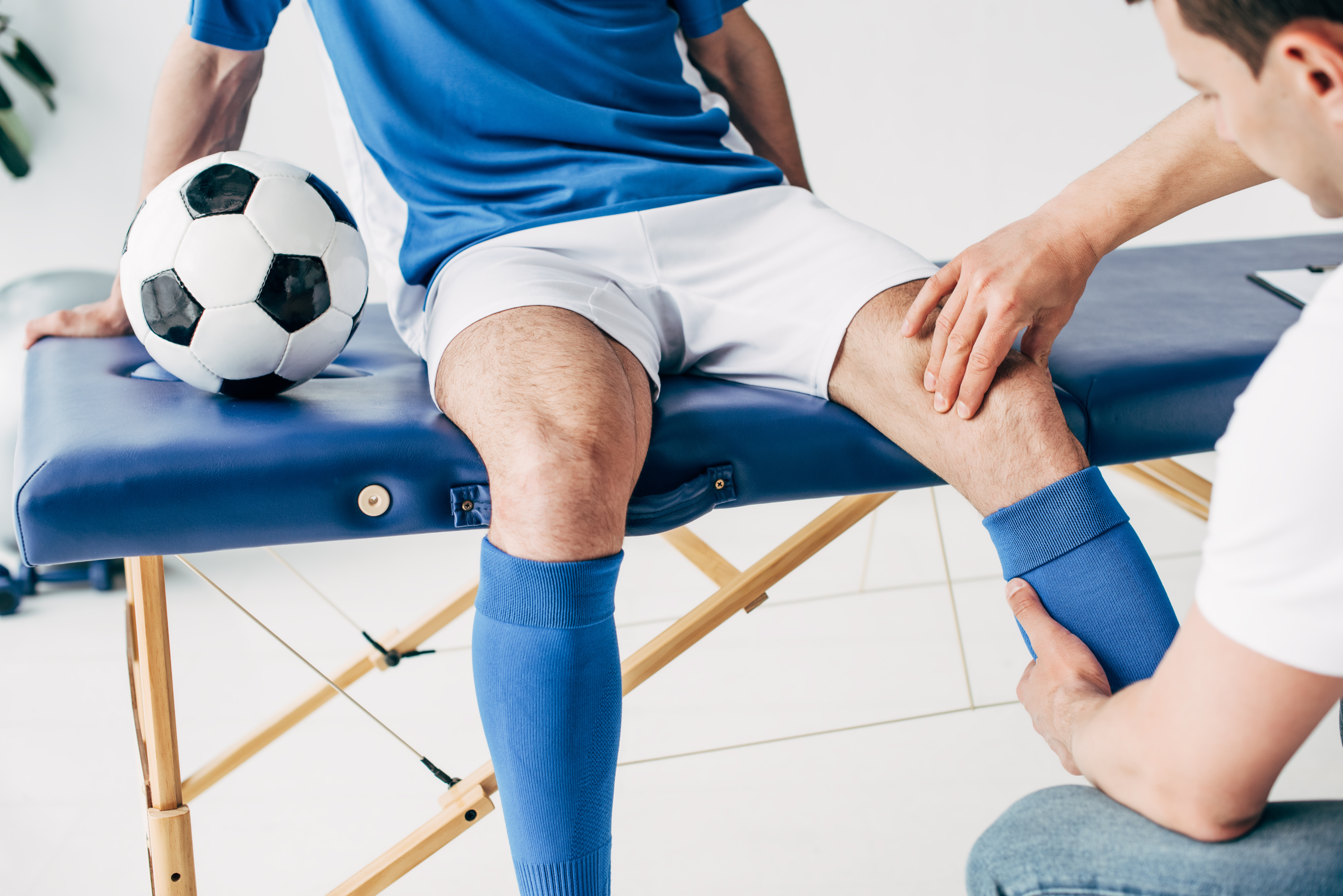
Professional athletes have physically demanding jobs and put their bodies under tremendous pressure and strain as they strive to reach the peak of their performance. As a result, they are more prone to injuries and illnesses — and not just the usual bumps, bruises, and scrapes that come with being active. This means athletes need specialized medical attention, which is where the sports medicine team comes in.
Sports medicine is a branch of medicine that focuses on diagnosing and treating injuries, illnesses, and disabilities related to sports, physical fitness, and exercise. It helps athletes and other active individuals prevent, diagnose, and treat sports-related injuries, improve athletic performance, and promote overall health and well-being.
This blog post will discuss the different aspects of sports medicine and how they can help individuals stay healthy and active.
What is Sports Medicine?

Sports medicine includes identifying, diagnosing, treating, and preventing physical conditions caused by the exertion of participating in competitive sports activities. The main focus of sports medicine is injuries related to playing sports and other types of exercise. These include sprains, fractures, dislocations, tendinitis, muscle strains, ligament tears, and other injuries.
Sports medicine also focuses on research initiatives to develop new injury prevention and treatment methods, new sports equipment and technologies, and new design of medical equipment for athletes. It also involves studying and identifying safe drugs and treatments for athletes who need them and the knowledge about the proper diet, nutrition, training, and exercise for athletes who want to improve their performance.
Sports medicine also includes psychology, biomechanics, and other areas to help optimize athletic performance. While sports medicine focuses on professional athletes and active individuals, it is not limited to them. It also applies to people of all ages and abilities who want to become more physically active or maintain a healthy lifestyle. It’s also open to people who experienced injuries or illnesses that need rehabilitation to regain their physical ability.
What Does Sports Medicine Include?
Sports medicine is a multidisciplinary field involving various aspects to provide comprehensive and personalized care for the unique needs of athletes, athletic trainers, active individuals, injured people, and more.
Sports medicine incorporates several specialties and sports medicine professionals.
Sports Medicine (Primary Care)
Primary care sports medicine centers around diagnosing, evaluating, treating, preventing, and rehabilitating injuries related to sports. Primary care sports medicine doctors include pediatricians, family medicine doctors, and internal medicine doctors specializing in sports medicine. They handle various medical and musculoskeletal problems, such as:
- Dislocations
- Fractures
- Sprains and strains
- Ligament injuries
- Tendinitis
- Apophysitis
- Overuse injuries
- Cartilage injuries
- Concussions
- Diabetes
- Eating disorders
Orthopedic Sports Medicine
Orthopedic sports medicine is a specialty and a subspecialty of orthopedic surgery that focuses on diagnosing, treating, and preventing musculoskeletal injuries related to sports. Orthopedic surgeons provide surgical and non-surgical treatments and handle various musculoskeletal conditions, including:
- Fractures
- Dislocations
- Ligament injuries (ie ACL tear)
- Sprains and strains
- Bone and joint infections
- Gait abnormalities or limping
- Apophysitis
- Tendinitis
- Overuse injuries
- Cartilage injuries
- Limb and spine deformities, such as clubfoot and scoliosis
Athletic Training

Athletic training involves preventing, evaluating, treating, and rehabilitating injuries related to physical activity and sport. Certified athletic trainers (ATC) work with athletes and active individuals who have sustained an injury or are prone to sustaining specific sports injuries.
ATCs are the first to assess injuries, provide initial care, develop individualized recovery plans, and determine when an athlete can resume their activity. They also work closely with primary care sports medicine doctors, orthopedic surgeons, physical therapists, and other healthcare professionals to restore the patient to their best condition.
Physical Therapy
Sports physical therapists (PTs) provide treatment and rehabilitation services to help patients regain their full range of motion and restore their body’s natural functions. Physical therapists work with injured athletes, active individuals, and others who need rehabilitation after an injury or illness.
PTs help athletes recover from the initial injury or condition by developing individualized exercise programs and providing ongoing assessments to ensure the patient progresses. They use a variety of techniques, including:
- Manual therapy (massage and stretching)
- Therapeutic exercises
- Strength training
- Joint mobilization
- Electrical stimulation
- Ultrasounds
- Heat and cold therapy
- Kinesiotaping
These methods encourage tissue healing and restore function to injured area.
Podiatry

Podiatry involves diagnosing and treating lower extremity conditions, including the feet, ankles, and legs. Its focus is to help athletes with foot and ankle injuries that can limit performance or cause pain. The knees, hips, and back are not typically treated with podiatry.
Podiatrists use surgical and non-surgical methods to treat foot and ankle problems. They also run diagnostic tests, prescribe medication, order physical therapy, and create personalized medical equipment for treating foot conditions.
Chiropractic
Chiropractic care focuses on the musculoskeletal system and its relationship to the nervous system. It treats neuromuscular conditions like back pain, neck pain, headaches, joint injuries or strains, and sports-related injuries.
Chiropractors use techniques such as manual manipulation, mobilization, and soft tissue therapies to help patients recover from spinal injuries, malalignment, or chronic health conditions.
Physiotherapy
Physiotherapy seeks to improve the athlete’s function and quality of life through exercise, manual therapy, and physical activity. The focus is restoring the movement of the body parts that have experienced injury or illness.
Physiotherapists use a variety of treatments to help reduce pain, increase range of motion and flexibility, improve cardiovascular health, and strengthen weak muscles. They create individualized treatment plans to help athletes recover and return to their sport or activity at total capacity and prevent future injury.
Physical Medicine and Rehabilitation
Physical medicine and rehabilitation (PM&R) is a medical specialty that treats muscle, bone, and joint problems. PM&R practitioners offer non-surgical treatments such as medications, physical therapy, occupational therapy, lifestyle changes, and education to manage pain and restore function. They also develop customized rehabilitation plans additional training and enhancement programs to help athletes improve their performance.
Sports Nutrition

Sports nutritionists help athletes fuel their bodies for optimal performance by educating them about the effects of proper nutrition and diet on health and athletic performance. Sports nutritionists provide diet recommendations, meal plans, and other dietary advice tailored to an athlete’s needs. The goal is to support healthy eating habits and weight gain and optimize physical condition.
Rheumatology
Rheumatology is a branch of medicine that focuses on diagnosing and treating musculoskeletal diseases. It deals with arthritis, rheumatic fever, and other autoimmune disorders. Rheumatologists may treat patients with medications and pain relievers, exercise, physical therapy, and lifestyle changes.
Sports Psychology
Sports psychology studies how psychological factors and mental states affect athletic performance. The discipline seeks to help athletes improve their cognitive skills, build confidence, cope with stress and anxiety, and better handle stress. Sports psychologists work with athletes through counseling sessions and goal setting to increase motivation, set achievable goals, and learn techniques for dealing with pressure.
Why is it Called Sports Medicine?
Sports medicine dates back to ancient Greece, where athletes and trainers were educated on protecting their bodies and treated with massage and other techniques to improve their performance. In the fifth century, a Greek trainer named Herodicus was the first known physician to use exercise to treat diseases, and he was later called the “father of sports medicine.”
In America, the American Medical Society for Sports Medicine was founded in 1954, and its members focused on researching and promoting sports-related health topics. The American Orthopedic Society for Sports Medicine was established in 1972 to help orthopedic surgeons treat and prevent athletic injuries. The American Medical Society for Sports Medicine was founded in 1991 to further research and education on sports medicine. In 1992, the American Board of Emergency Medicine recognized sports medicine as a subspecialty.
It is unknown when the term “sports medicine” was first coined, but it has since become an umbrella term for the medical field dealing with athletic injuries and performance. Today, sports medicine is an interdisciplinary field encompassing several medical specialties that work together to help athletes improve their health and performance and prevent injuries.
When to Seek a Sports Medicine Doctor
While sports medicine specializes in treating professional athletes, it is not exclusive to professional or amateur athletes. Anyone who participates in physical activity can benefit from seeing a sports medicine doctor. People with injuries, disabilities, or chronic pain can receive diagnosis and treatment, whether from sports or other activities. Those who want to improve their performance, prevent injuries, or better manage a chronic condition can also benefit from a sports medicine specialist and care.
Common signs that may indicate you should seek medical help include:
- Pain during exercise
- Difficulty performing certain activities
- Fatigue after physical exertion
- Recurring injuries
- Issues with coordination, balance, and posture
- Limited mobility
- Knee and shoulder injuries
If you are experiencing any of these symptoms, it is crucial to seek medical help as soon as possible. A sports medicine doctor can provide a diagnosis and treatment plan that will help restore your physical health and improve your performance.
Contact Academy Orthopedics!
Sports medicine is available for people of all ages and fitness levels. Academy Orthopedics provides comprehensive sports medicine services, from diagnosis and treatment to rehabilitation, performance enhancement, and injury prevention. Our highly-trained sports medicine specialists are dedicated to helping you reach your peak performance goals.
Contact us today at (770) 271-9857 or book an appointment here to maximize your physical health. To read more of our content, visit our Blog page or follow us on Social Media: Facebook and Twitter.
